The distinctive style of Japanese lacquerware can be found on a wide variety of antiques, from cabinets and tables to clothing accessories. Whether the item is authentic or inspired by Edo patterns, many lacquer antiques will require professional restoration due to their sensitive surface and historic materials.
 Above: a selection of lacquer antiques including an early 18th century high chest with ‘Japanning’ details, incense boxes, a picnic set, sake ewers and and a red lacquer inro
Above: a selection of lacquer antiques including an early 18th century high chest with ‘Japanning’ details, incense boxes, a picnic set, sake ewers and and a red lacquer inro
This article will look into the history of lacquerware as an ancient cultural artform, including the famous maki-e 蒔絵 decoration that has adorned it for centuries. We will also offer insights from our studio on the restoration and conservation of lacquer furniture, as well as the many other antiques you may come across in this much-admired genre.
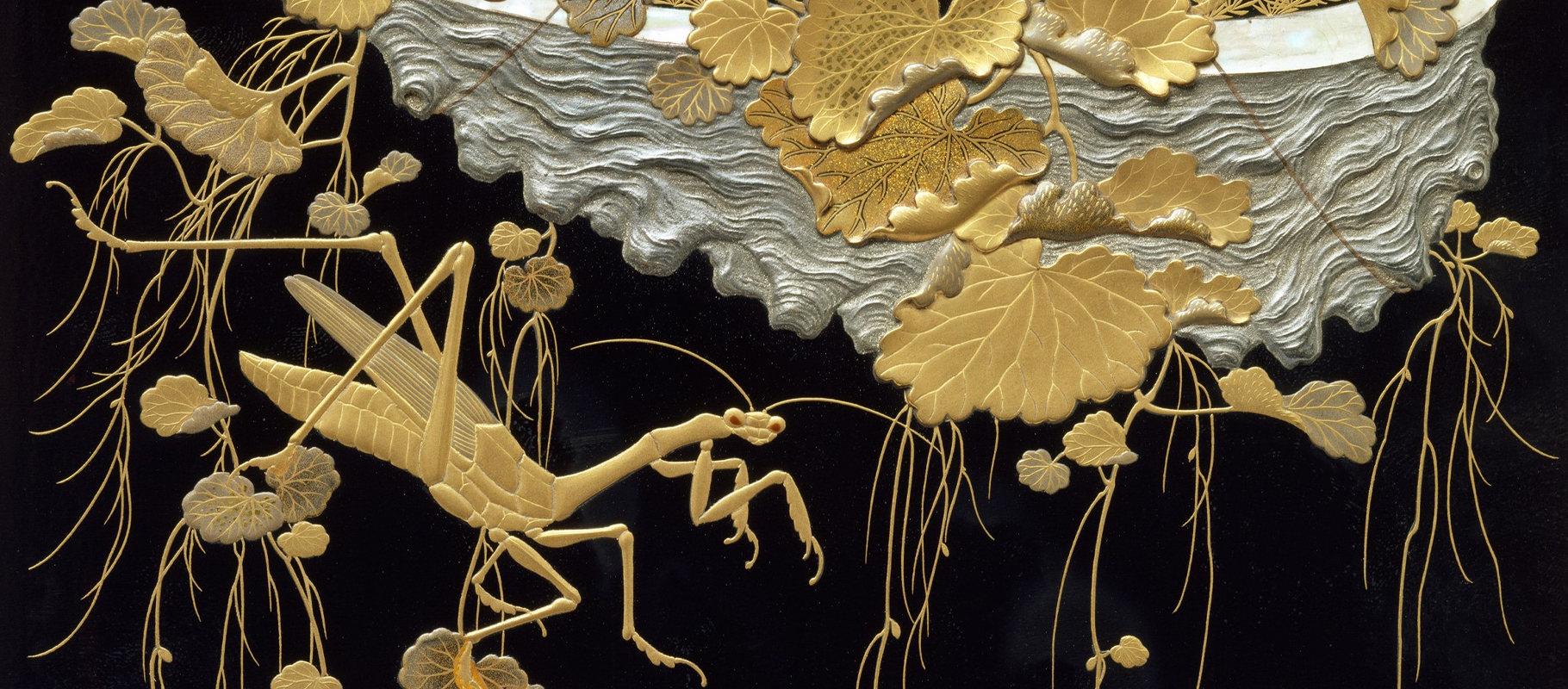 Above: a detail from the lid of a Japanese Shikishi box, second half of the 19th century
Above: a detail from the lid of a Japanese Shikishi box, second half of the 19th century
How is lacquerware made?
True Japanese lacquer antiques are coated in the sap of the toxicodendron vernicifluum tree known as urushi 漆 or urushiol. This resin would have been dried, treated and coloured prior to use.
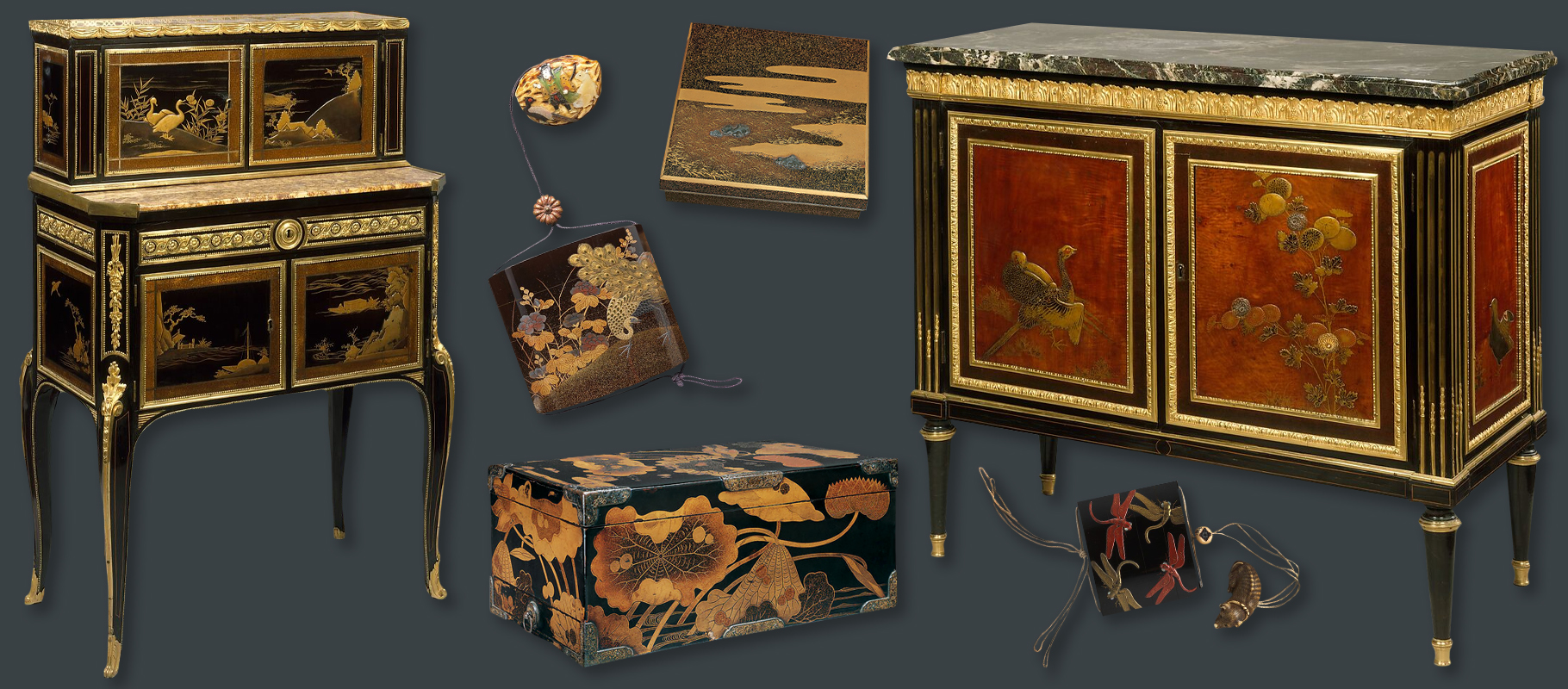 Above: a selection of lacquerware including inro accessories, writing boxes and two French commodes with Japanese lacquer panels
Above: a selection of lacquerware including inro accessories, writing boxes and two French commodes with Japanese lacquer panels
Lacquer is primarily a protective, waterproof coat for a wooden or paper object, providing a long-lasting outer seal that gives a distinctive shine. The clear base is perfect for detailed decorative elements that may have otherwise been obscured by the texture and natural grain of the interior materials.
 Above: a detail of an inro with maki-e decoration and a red lacquer dragonfly on black lacquer
Above: a detail of an inro with maki-e decoration and a red lacquer dragonfly on black lacquer
With techniques dating back thousands of years, the toxicodendron vernicifluum sap is refined over several months using different ingredients to create desired colours. For example cinnabar and iron oxide are added to produce red lacquer. The application process would generally see three to four coloured layers coated onto the furniture or object, before the decoration is completed. There may be a final clear layer to add further protection to the decorative elements.
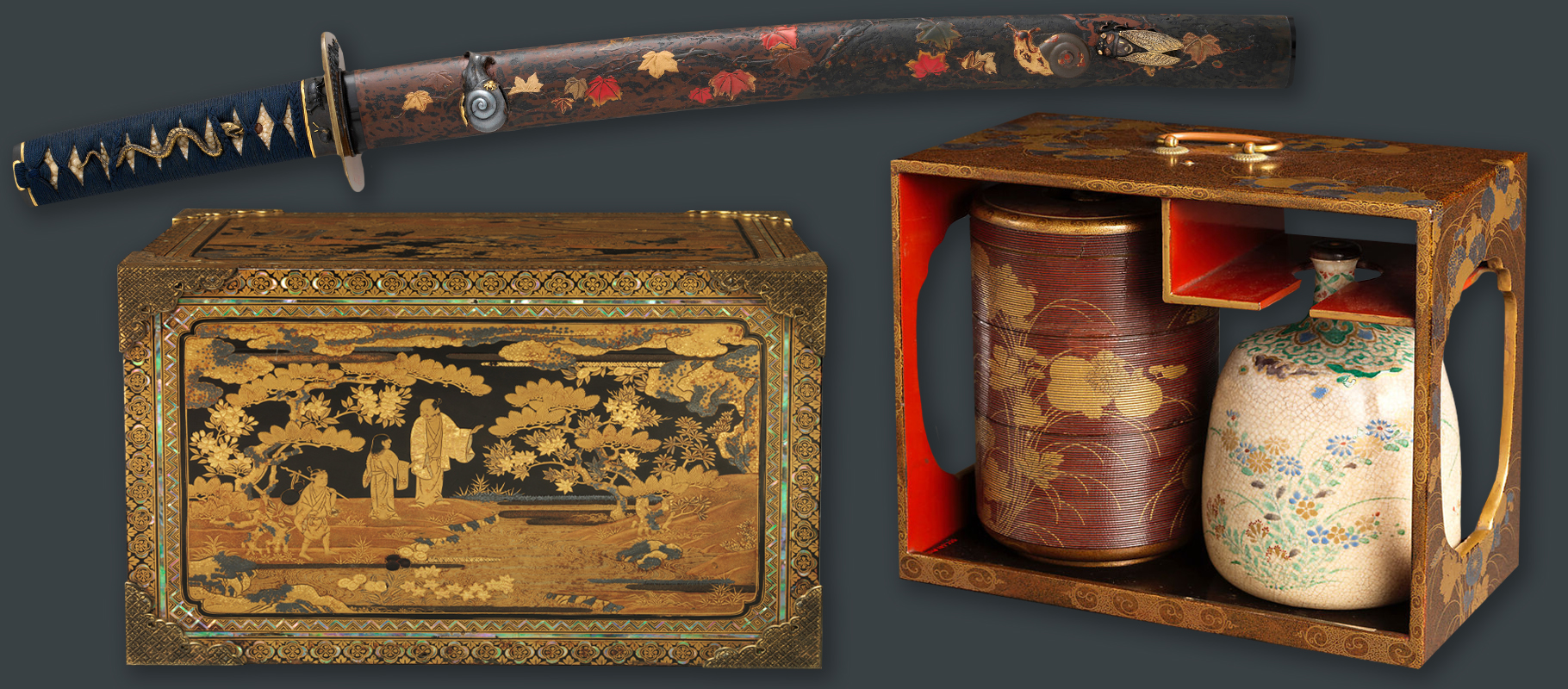 Above: Japanese lacquerwork items including a Wakizashi case, cabinet box and picnic set
Above: Japanese lacquerwork items including a Wakizashi case, cabinet box and picnic set
Metallic decoration on Japanese lacquerware is known as maki-e 蒔絵. This is usually a fine power, such as gold mica, applied with specialist techniques. Due to the many forms it can take, maki-e is a highly skilled craft that requires many years of training to become a master.
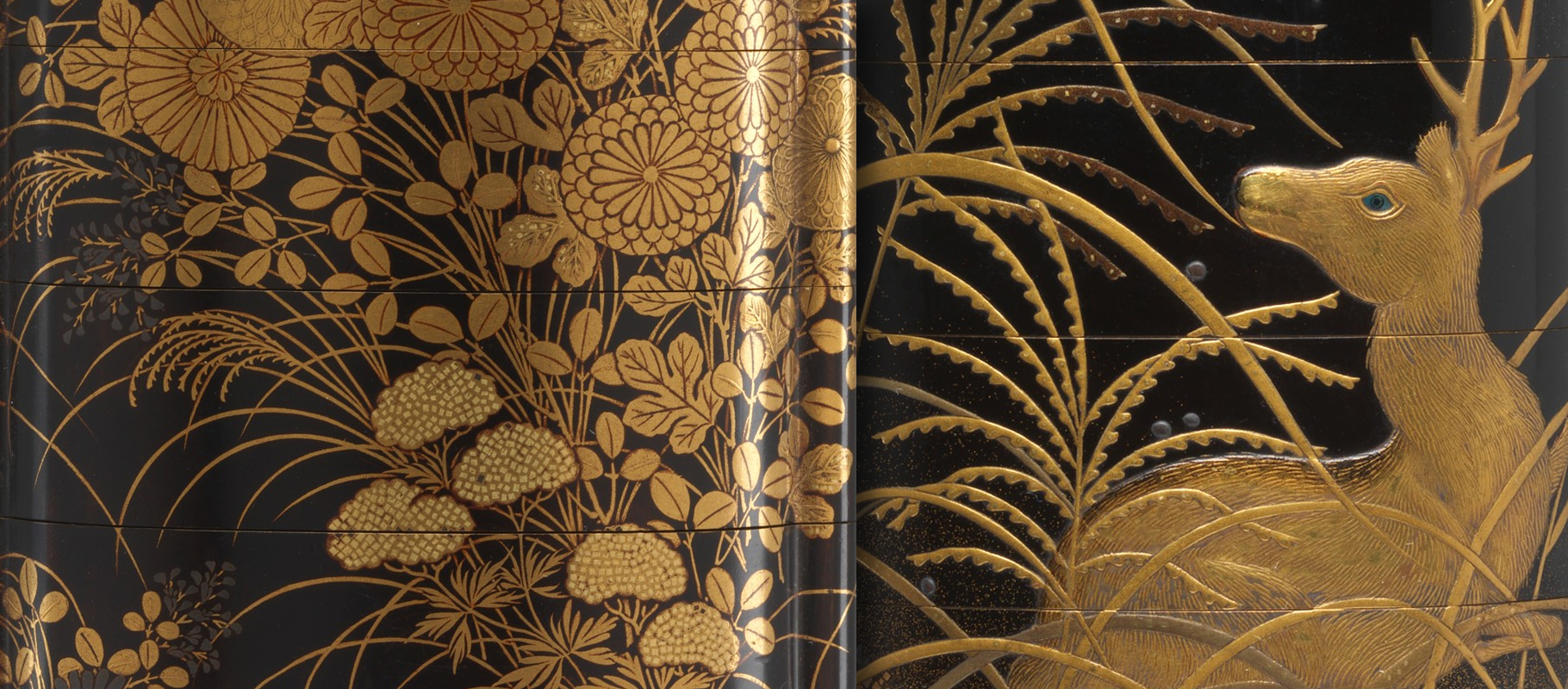 Above: details of two inro accessories with traditional black and gold decoration
Above: details of two inro accessories with traditional black and gold decoration
Japanese lacquerware in Europe and North America
The term Japanning refers to the copy of Japanese lacquer designs by European or North American craftsmen. One of the first manuals featuring Japanning was published in Oxford in 1688, soon after examples could be found in the catalogues of English cabinet makers as well as British colonies. Japanning remained popular throughout the 18th century and was often interchangeably combined with other Asian influences such as Chinoiserie.
 Above: lacquer drop-front secretary and commode with Japanese panels designed by Jean Henri Riesener for Marie Antoinette, 1783
Above: lacquer drop-front secretary and commode with Japanese panels designed by Jean Henri Riesener for Marie Antoinette, 1783
Whilst Japanese lacquering is completed using toxicodendron vernicifluum tree sap, European and American craftsmen did not have access to this material. Imitations typically used enamel paint upon a resin base, built up in layers before being finely polished. The word Japanning is most often used in reference to black lacquer furniture with gold details, imitating the maki-e style of decoration. In some cases, authentic Japanese lacquer was repurposed – 17th century Japanese panels can be found on furniture created for many European courts including Versailles.
 Above: an Adam Weisweiler commode with authentic Japanese lacquer panels that have been repurposed, 1790
Above: an Adam Weisweiler commode with authentic Japanese lacquer panels that have been repurposed, 1790
Japanning became a pastime for girls and women during the late 17th and early 18th centuries. It was considered similar to decoupage and many Japanese inspired pattern books were aimed at a female audience. It was not until 1760, around the same time of Thomas Chippendale’s successful cabinet maker’s catalogue, that Japanning became a fully commercial trade.
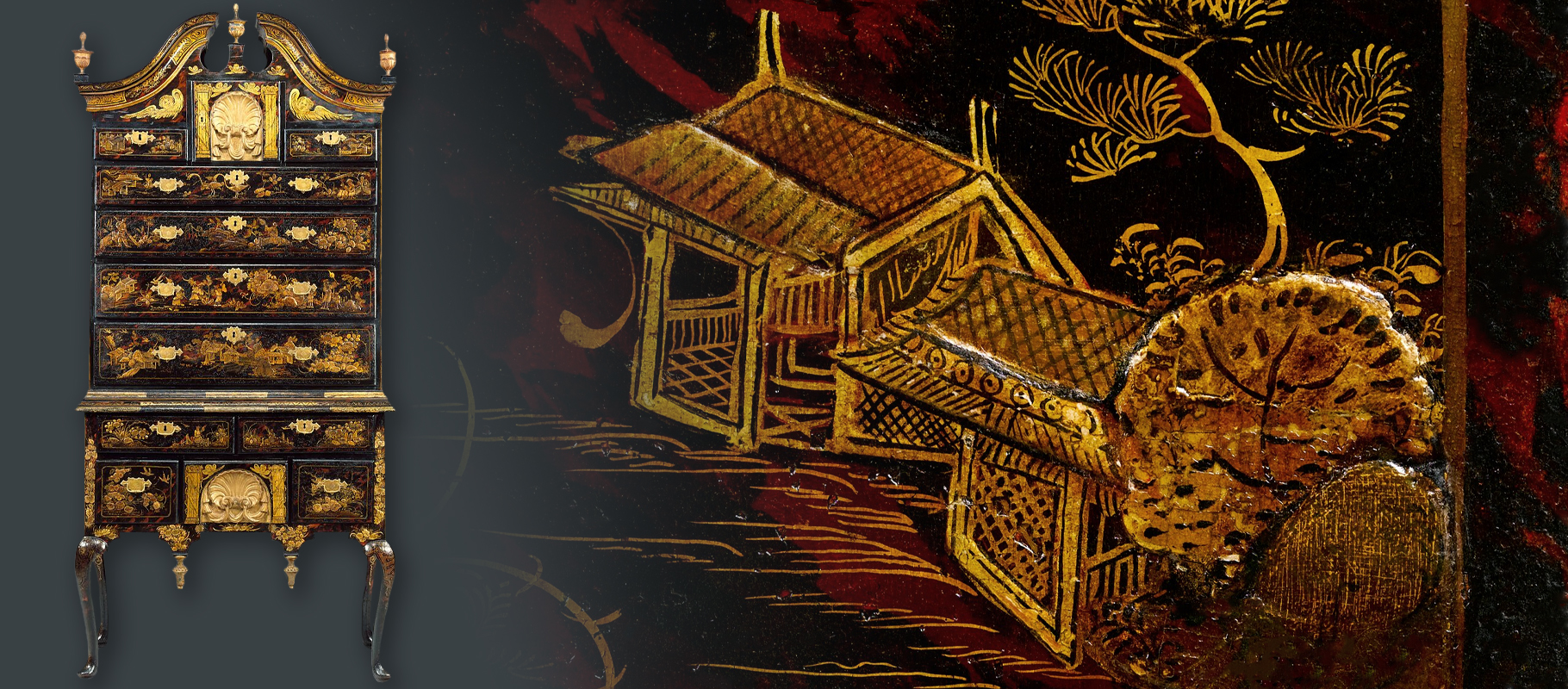 Above: an American high chest with Japanning decoration, mid 18th century
Above: an American high chest with Japanning decoration, mid 18th century
Japan was an isolationist nation for 265 years until the mid 19th century. When world trade reopened, Japanese goods became extremely popular in Europe and this decorative revival became known as Japonisme. Lacquerware was very fashionable during this period, whether it was an authentic piece of furniture or a cheaper, local imitation for those with a more modest budget.
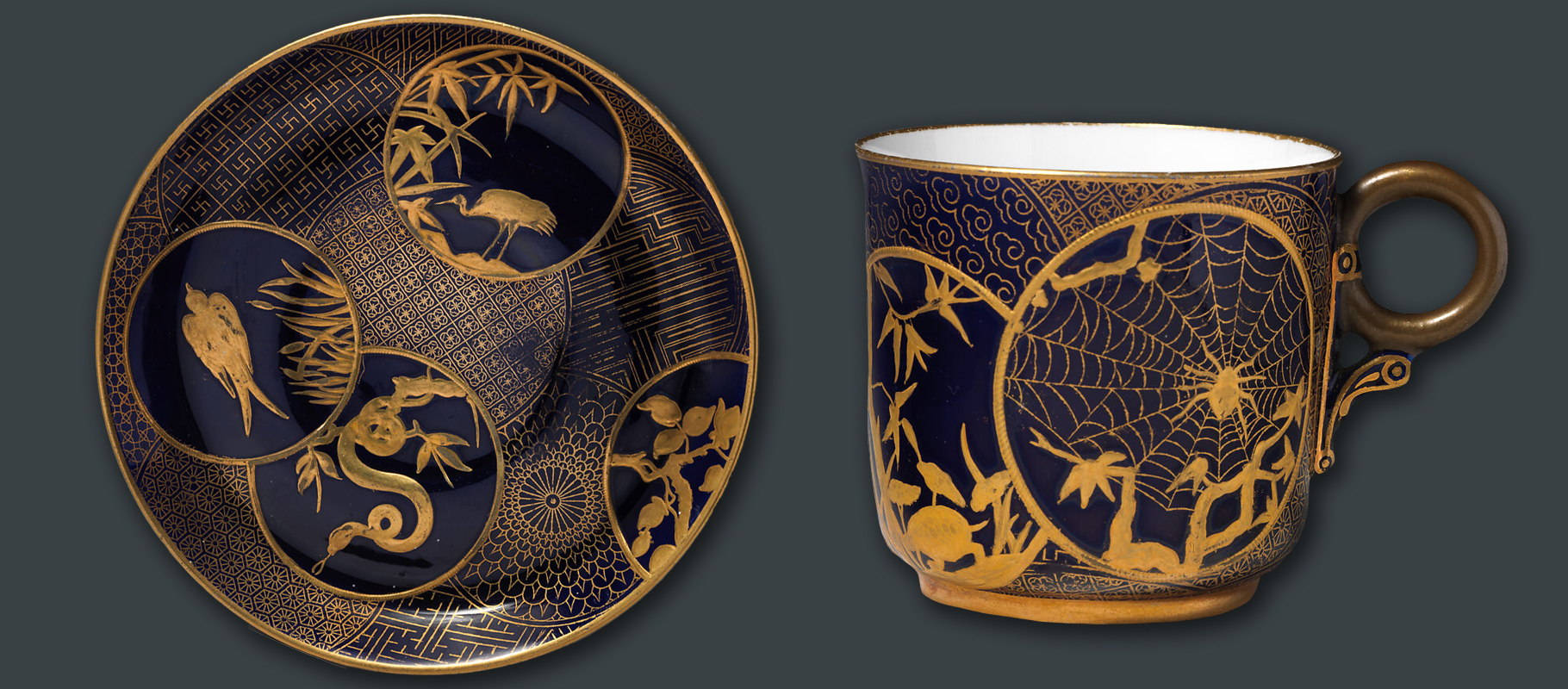 Above: a plate and cup by Royal Worcester imitating Japanese lacquerwork, 1876–77
Above: a plate and cup by Royal Worcester imitating Japanese lacquerwork, 1876–77
Protecting lacquer antiques
Although lacquer is originally a robust surface, antique pieces can begin to deteriorate over time and can therefore become easily damaged through everyday use. The following points will help you to protect your lacquer furniture at home:
- Keep away from liquids, do not place cups or mugs on the surface as this may lead to blanching and blemishes as the moisture penetrates the lacquer.
- Skin contact may disturb the lacquer or metallic decoration, when handling wear soft cotton gloves to avoid touching sensitive areas.
 Above: detail from a Chinese lacquer table prior to restoration – showing signs of water damage and surface deterioration
Above: detail from a Chinese lacquer table prior to restoration – showing signs of water damage and surface deterioration
- Dust with a very soft cloth or brush regularly (this should be completely dry – without any cleaning liquids) to prevent build-up in cracks and decorative features. Dusting is especially important if it is in an environment with an open fireplace.
- Position away from direct sunlight to lessen fluctuations in temperature and discolouration.
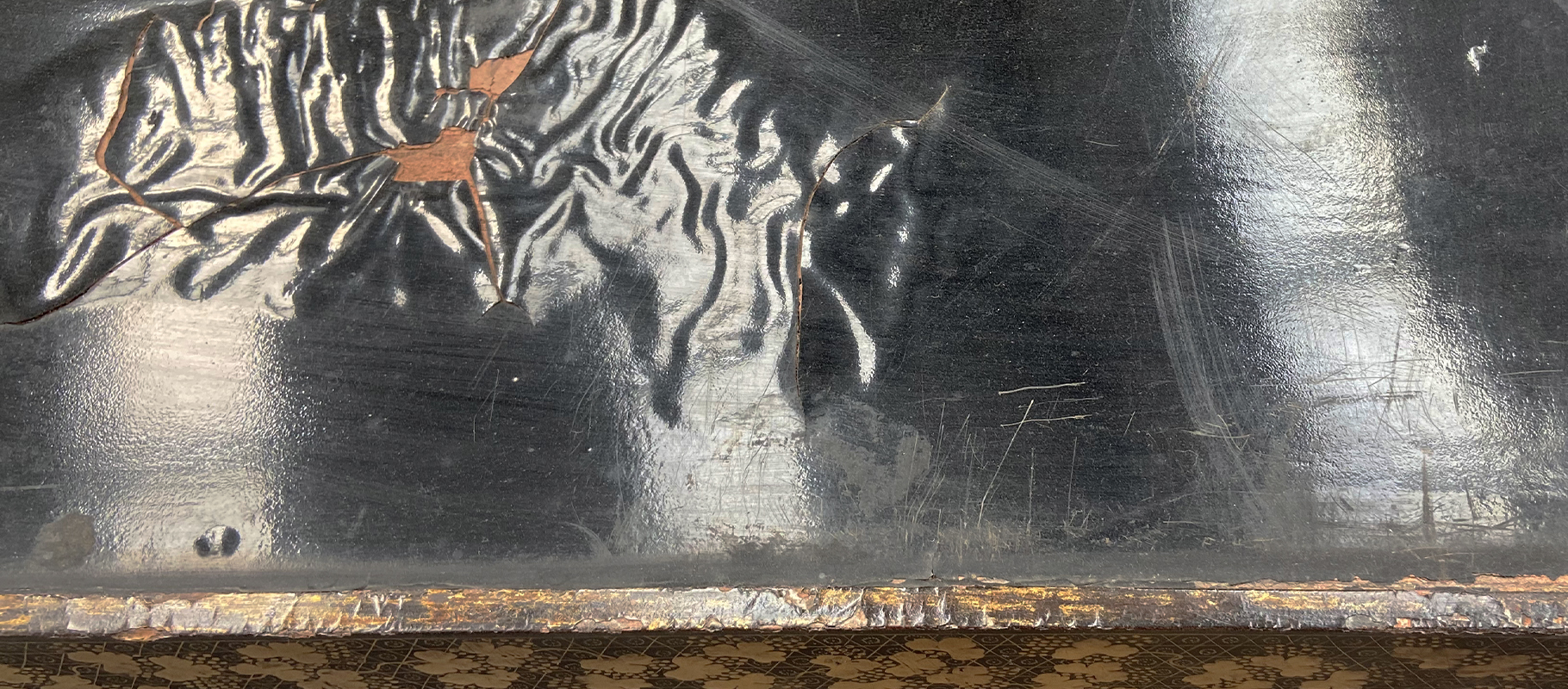 Above: a detail from a piece of damaged lacquer furniture in our studio, prior to restoration
Above: a detail from a piece of damaged lacquer furniture in our studio, prior to restoration
- Take care not to disturb inlays or three-dimensional decorative areas when dusting, if a piece becomes loose consult our conservation team and do not attempt to glue it back into position with household adhesives – this will cause further damage in the long term.
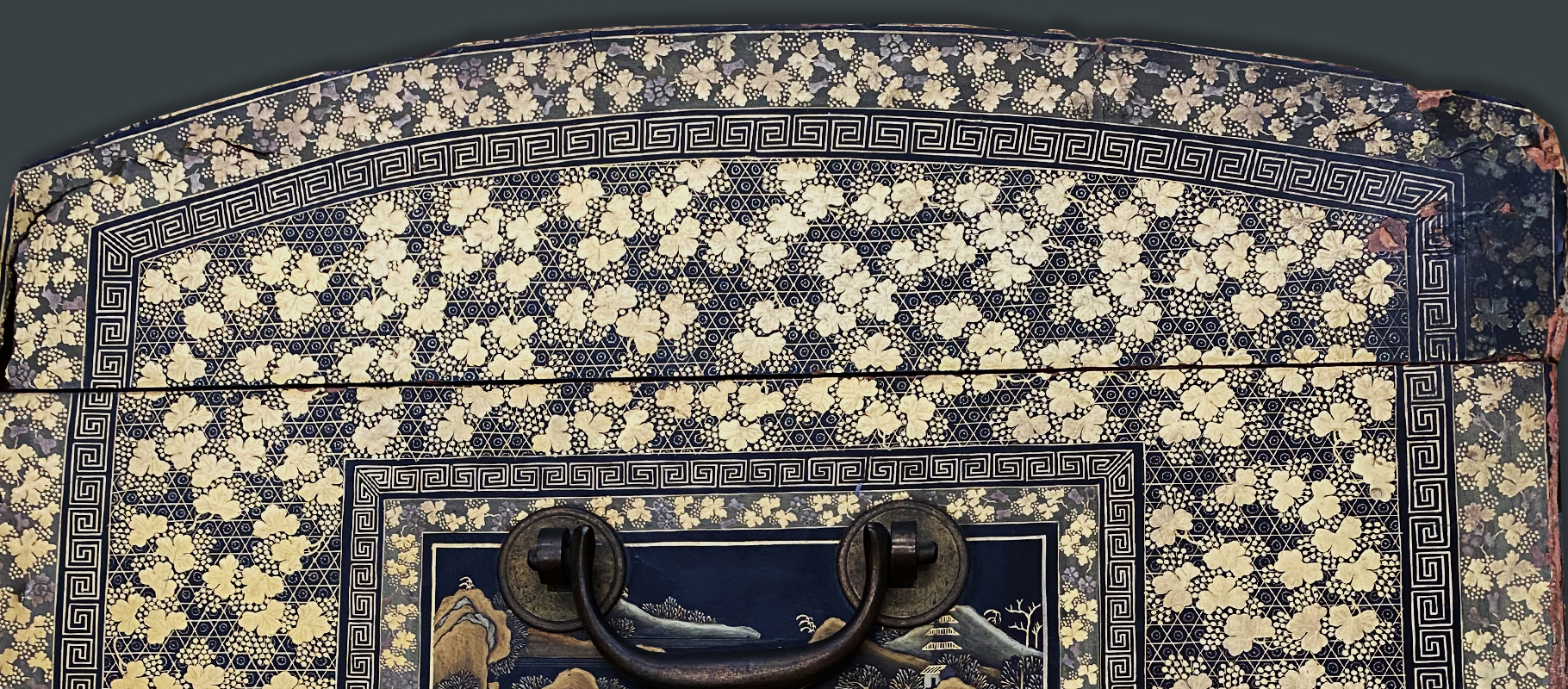 Above: close-up of a lacquerwork chest with deteriorating corners – leaving the internal wooden structure vulnerable to decay
Above: close-up of a lacquerwork chest with deteriorating corners – leaving the internal wooden structure vulnerable to decay
In some instances, you may be able to wax the lacquerware to provide further protection – this should only be completed if the furniture is strong and intact without any surface damage or flaking. If you have any concerns about your lacquer furniture, please speak to a member of our helpful team for further advice and professional assistance.
Restoring lacquerware
Today, Japanning is not taught as a new furniture-making skill for craftsmen and is instead part of a conservation focus in specialist schools. This means that rather than continuing to copy Japanese antiques, contemporary British cabinet-makers such as our antique furniture experts, have learnt how best to protect and preserve lacquer furniture without disturbing or over-restoring the important original details. In our studio, antique furniture is restored using traditional techniques to ensure stability in a way that does not alter the historic value of an item.
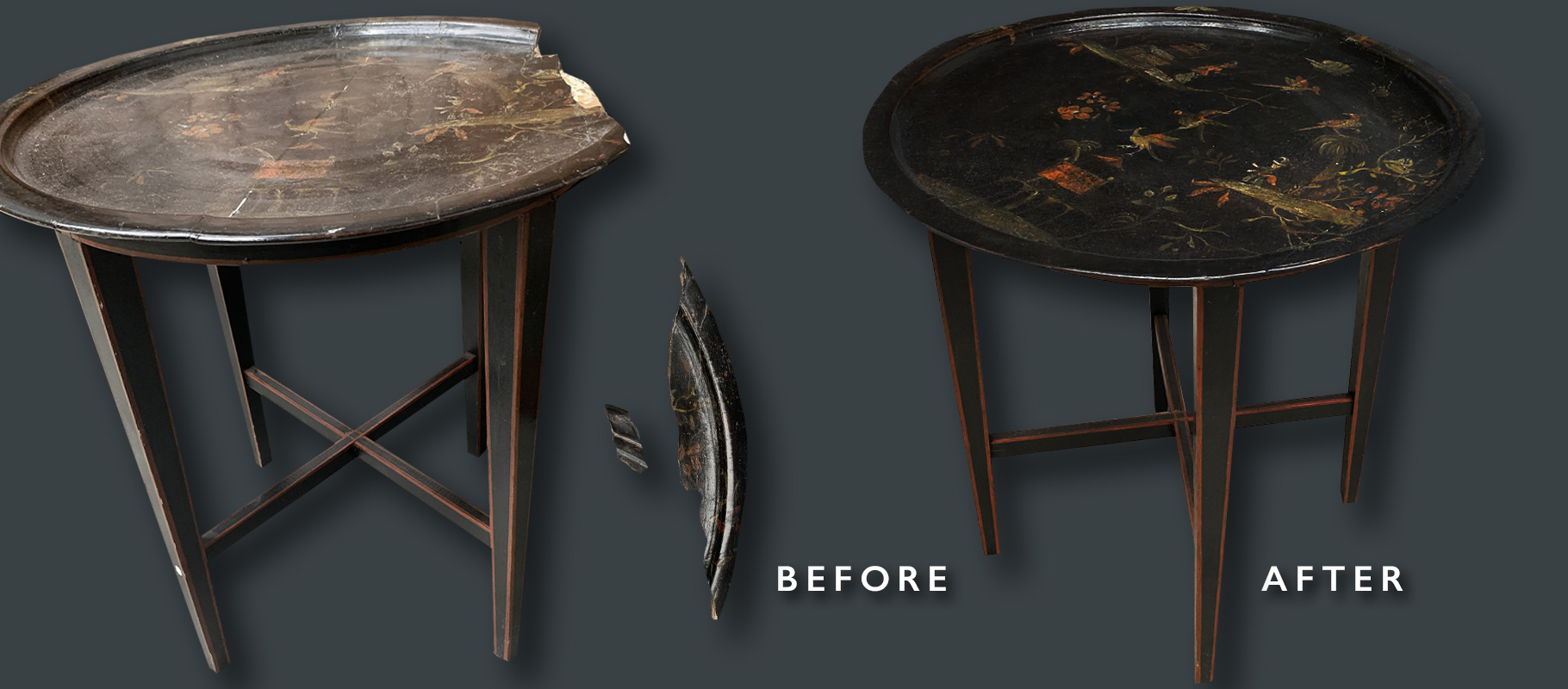 Above: a lacquer side table before and after restoration by our team
Above: a lacquer side table before and after restoration by our team
Due to the prominent colours and details of lacquer antiques, our painting and gilding conservators may collaborate with our furniture team to provide an accurate finish. In areas of lost decoration, our conservators sensitively retouch the details using appropriate materials such as gold mica powder. Their expertise and skill allows them to accurately copy historic designs and retouch faded or lost areas with integrity.
Cracks and areas of flaking can be safely stabilised to prevent further deterioration. Likewise, loose pieces of inlay can be reapplied with safe solutions or completely recreated if they have become lost. This is important as any open areas of the wooden base may be vulnerable to decay, having all pieces of inlay in place will help to strengthen the overall piece.
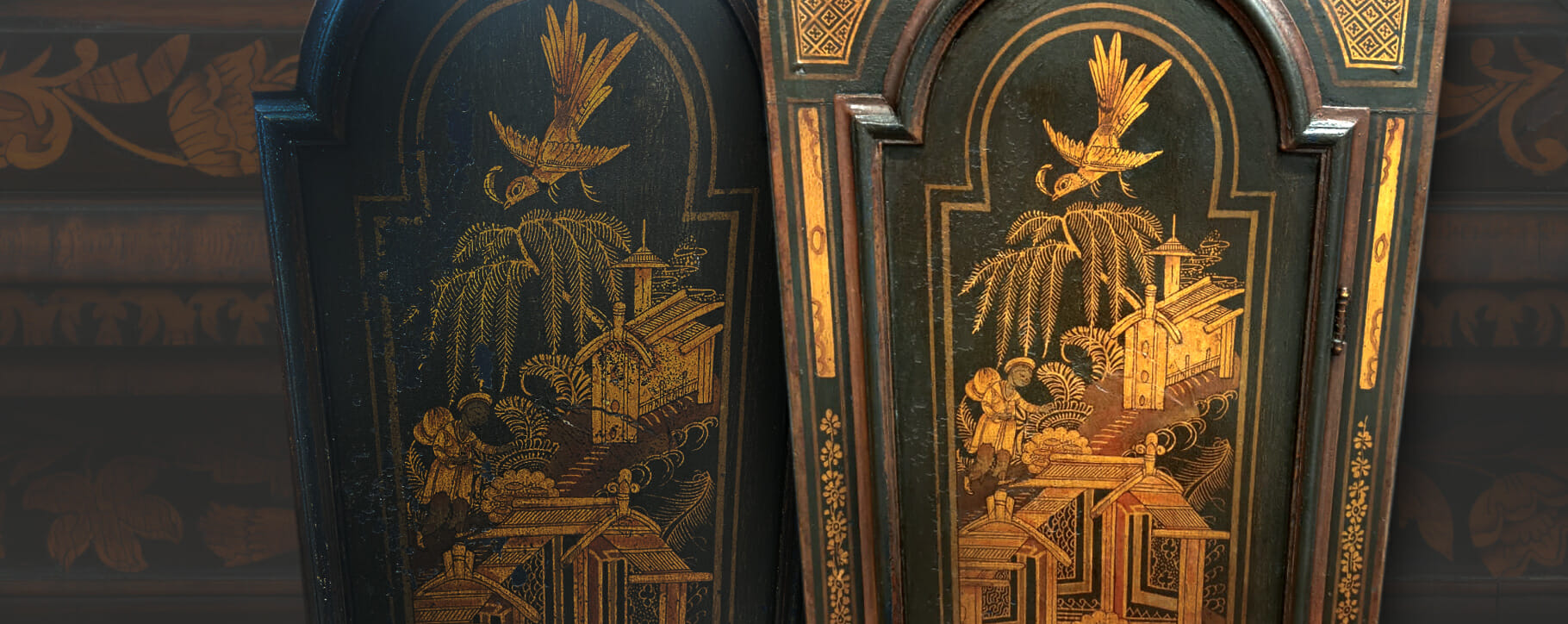 Above: a detail from a longcase clock that was restored by our team, this was a European copy of a typical lacquerwork design
Above: a detail from a longcase clock that was restored by our team, this was a European copy of a typical lacquerwork design
Like all antiques, the fine details may become discoloured or darkened over time due to atmospheric contamination. Our conservators can sensitively clear away any build up of dust, soot and surface dirt with a solution that will not adversely affect the decorative features.
How can we help?
If you have any questions about japanese lacquerware techniques or have an item in need of lacquer restoration, please get in touch today. Email us via [email protected] or call 0207 112 7576






